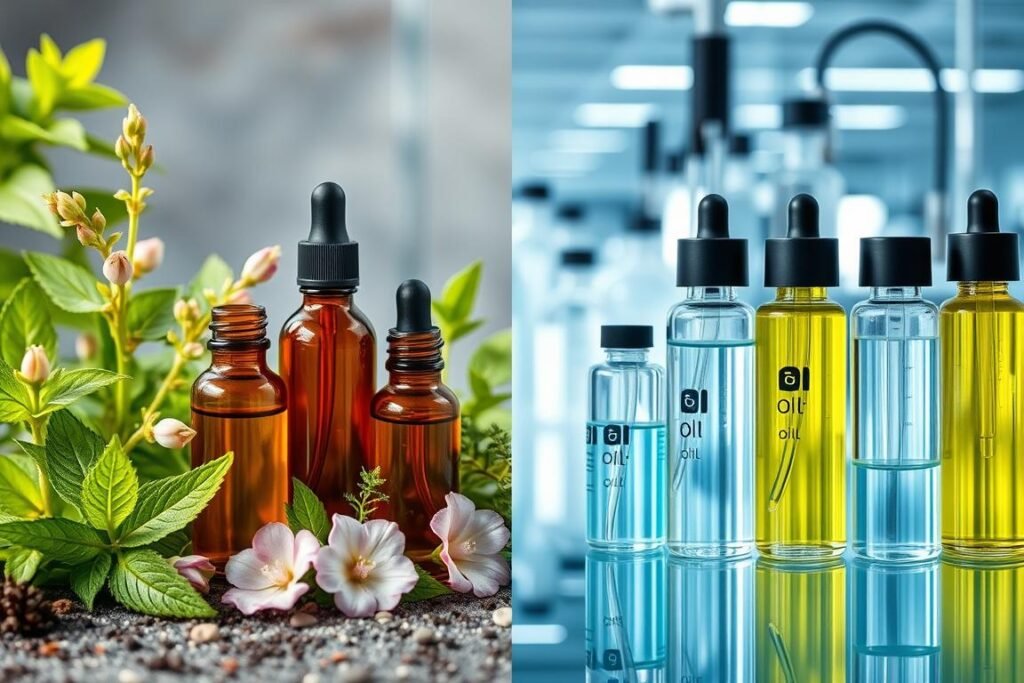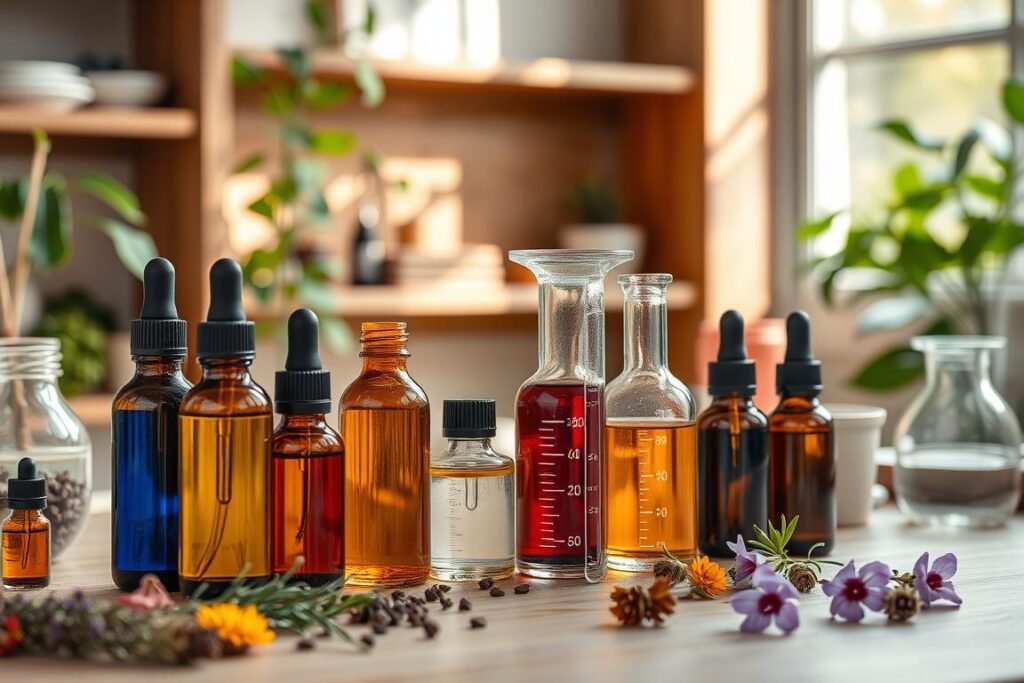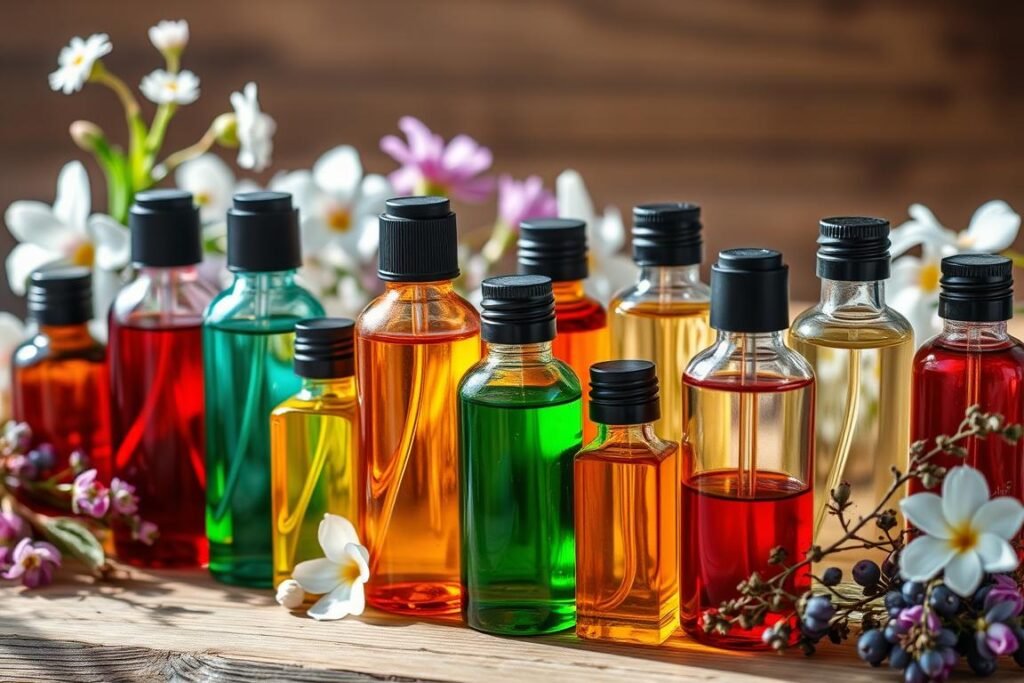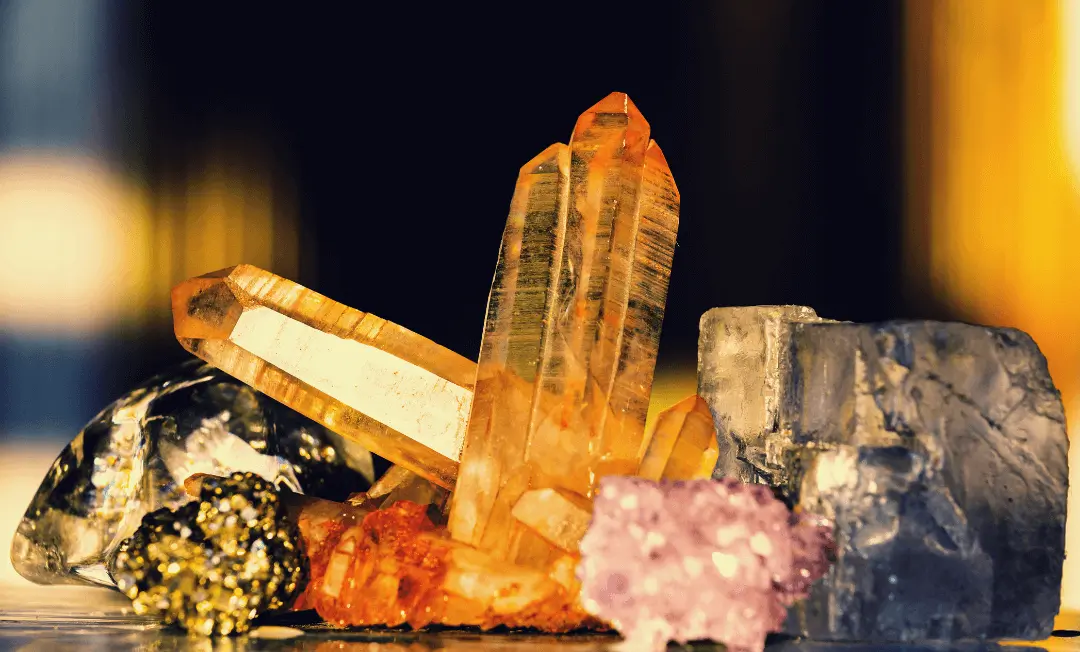I love perfume and the art of making scents. Choosing the right oils is key to creating amazing fragrances. In this guide, we’ll look at the best oils for making perfume. You’ll learn about essential oils and synthetic fragrance oils, and how to make your own unique scents.
Fragrance oils, or synthetic oils, mimic natural scents or create new ones. They’re great for many uses, like perfumes, candles, soaps, and diffusers. Unlike essential oils, which come from plants, fragrance oils are made in labs. This gives us a wide range of scents.
Fragrance oils are very versatile. You can mix them with carrier oils like jojoba or sweet almond to make your own perfumes. For a 5ml perfume bottle, use 2 parts base, 1 part heart, 1 part head, and the rest carrier oil. This mix creates a scent that lasts and can be customized to your liking.
Key Takeaways
- Fragrance oils are synthetically manufactured to mimic natural scents or create new aromas
- They offer versatility in a wide range of applications, including perfume making, candles, and diffusers
- Proper dilution of fragrance oils in a carrier oil or alcohol base is essential for safe skin application
- Aroma Energy provides a diverse range of fragrance oils suitable for perfume making, including designer-inspired scents
- The typical dilution ratio for perfume use is 1 part fragrance oil to 10 parts carrier oil or alcohol
The Importance of Choosing the Right Oil for Fragrance
Choosing the right oil is key to creating captivating fragrances. It’s about understanding fragrance notes and the role of carrier oils. Let’s explore what you need to know to pick the perfect oil for your scents.
Understanding Fragrance Notes
Fragrance notes are the foundation of any scent. They are divided into top, middle, and base notes. Each plays a unique role in how the fragrance develops over time.
Top notes are the first thing you smell, often short-lived. Middle notes, or heart notes, come next, giving the fragrance its core. Base notes are the lasting foundation, rounding out the scent.
The Role of Carrier Oils
Carrier oils, like jojoba or sweet almond oil, are essential. They dilute and blend fragrance oils safely. This makes your scents enjoyable and good for your skin.
Essential Oils vs. Synthetic Oils
There are two main types of fragrance oils: essential and synthetic. Essential oils come from plants, offering natural scents and benefits. Synthetic oils, made in labs, mimic natural smells.
Your choice depends on the scent you want, your preferences, and any allergies.
“The right fragrance oil can transport you to another world, evoking emotions and memories with a single whiff.”
Knowing about fragrance notes, carrier oils, and essential vs. synthetic oils helps you make better choices. Blend different oils to find your unique scent.
Popular Essential Oils for Fragrance Creation
Essential oils are key for making fragrances. They add unique scents and health benefits. Lavender oil, peppermint oil, jasmine oil, and sandalwood oil are favorites for making fragrances.
Lavender Oil
Lavender oil is known for its calming scent. It’s floral and sophisticated. It works well with many fragrances, great for perfumes and candles.
Peppermint Oil
Peppermint oil has a fresh, cool scent. It’s great for adding a refreshing touch to fragrances. It pairs well with citrus and wood notes.
Jasmine Oil
Jasmine oil has a sweet, floral scent. It’s used in luxury perfumes and personal care. It adds depth and complexity to fragrances.
Sandalwood Oil
Sandalwood oil has a warm, woody scent. It’s a good base for fragrances. It works well with other oils, making it versatile.
By mixing these oils, you can create unique scents. Experimenting with different blends can lead to amazing fragrances.
| Essential Oil | Fragrance Notes | Recommended Usage |
|---|---|---|
| Lavender | Floral, calming | Perfumes, candles, aromatherapy |
| Peppermint | Fresh, minty, cooling | Perfumes, room sprays, personal care |
| Jasmine | Rich, sweet, floral | Perfumes, luxury personal care |
| Sandalwood | Warm, woody, earthy | Perfumes, incense, aromatherapy |
“The true alchemist is not the one who transmutes lead into gold, but the one who transmutes the base metal of his nature into the gold of wisdom and understanding.”
Understanding Carrier Oils and Their Benefits
Carrier oils are key in making fragrances. They mix and dilute essential oils, making them safe for skin. Knowing about different carrier oils can make your fragrance-making better and more exciting.
What Are Carrier Oils?
Carrier oils, or base oils, come from plants. They help spread essential oils over the skin gently. These oils are mild and absorb well, making them great for natural perfumes and skincare.
Best Carrier Oils for Fragrance
- Jojoba Oil: It feels like your skin’s natural oil, so it absorbs easily. It leaves your skin smooth and doesn’t feel greasy.
- Sweet Almond Oil: It’s full of vitamins A and E, which are good for your skin. It also has a mild, nutty smell that goes well with fragrances.
- Fractionated Coconut Oil: It stays liquid at room temperature. It has a neutral smell and is light, making it perfect for mixing with other oils.
- Grapeseed Oil: It’s light and doesn’t feel greasy. It’s full of antioxidants, which help your fragrance smell better without being too strong.
- Argan Oil: It’s very moisturizing and adds a luxurious feel to perfumes. It has a nutty scent and is full of nutrients.
How to Mix Carrier Oils with Essential Oils
To mix carrier oils with essential oils safely, use 1-5% essential oil to carrier oil. This depends on how sensitive your skin is and how strong you want the scent. Start with a small amount and add more until you like the smell. Always keep your blends in dark glass bottles to keep them fresh and prevent damage.
The Difference Between Natural and Synthetic Oils
Choosing between natural and synthetic oils greatly affects fragrance formulation. Natural oils come from plants and offer a rich scent. They are loved for their health benefits and organic appeal. Yet, they can cause allergies in some people.
Synthetic oils, on the other hand, give a steady scent. They are cheaper and let us make scents that nature doesn’t have. Made from chemicals, synthetic oils might not have natural oils’ depth. But, they can be strong and impactful.
Pros and Cons of Natural Oils
- Offer complex, multi-layered scent profiles
- Possess therapeutic and restorative properties
- Preferred by those seeking organic and natural products
- May cause allergic reactions in some individuals
- Have a shorter shelf life of 1-2 years
- Contribute to deforestation due to harvesting from plants and trees
Benefits of Synthetic Oils
- Provide consistent and predictable scents
- Often more affordable than natural oils
- Allow for the creation of unique fragrances not found in nature
- Can have a longer shelf life of up to 5 years due to the use of fixatives
- Offer a wider range of scent profiles and intensities
When to Use Each Type
The choice between natural and synthetic oils depends on what you want. Natural oils are great for health benefits and organic fans. Synthetic oils are best for unique scents and those sensitive to natural oils. Mixing both can create the best fragrances.

“The best fragrances often strike a harmonious balance between the depth of natural oils and the versatility of synthetic compounds.”
How to Blend Oils for Unique Fragrance
Making your own fragrance is a fun adventure. It lets you create scents that are just right for you. You’ll learn about different notes and how they work together to make a scent that lasts.
Tips for Blending Oils
Begin with a base note like sandalwood or patchouli. These scents are deep and earthy. Then, add heart notes like jasmine or geranium for more depth. Finish with top notes like citrus or flowers for a bright start.
Experimenting with Ratios
Begin with the 30-50-20 rule: 30% base, 50% heart, and 20% top. This balance is a good start. But, don’t be afraid to try different amounts to find your perfect scent. Start small and keep track of what you do.
Aging Your Blends for Better Results
Let your fragrance sit for at least 48 hours, or up to a month. This lets the scents mix well. Keep your blend in dark glass bottles in a cool, dark spot. This makes your scent richer and more complex.
“The art of perfume-making is like alchemy, where you combine different elements to create something truly extraordinary.”
Blending oils is all about exploring and finding what you like. Be patient and keep trying new things. With time and practice, you’ll make a scent that’s truly yours.
Safety Considerations When Using Fragrance Oils
Using fragrance oils safely is crucial. They can have up to 5,000 ingredients, mostly from petroleum. This means they might have chemicals that can irritate your skin, like aldehydes and toluene.
Skin Sensitivity and Irritation
Always do a patch test before using new fragrance oils. Apply a small amount to a hidden skin area and watch for any reactions. Some oils can cause redness or itching, especially if your skin is sensitive.
Safe Dilution Practices
It’s important to dilute fragrance oils correctly. Use 1-5% fragrance oil in a carrier oil like jojoba or coconut oil. This reduces the chance of irritation and keeps the scent balanced.
Storage Tips for Oils
Storing fragrance oils right is key to their quality and safety. Keep them in dark glass bottles, away from sunlight and heat. Always seal the bottles tightly and keep them out of children’s and pets’ reach. Some oils can make your skin more sensitive to the sun, so avoid direct sun after use.

By following these safety tips, you can enjoy fragrance oils safely. Always prioritize your skin and health when using these products.
DIY Fragrance Projects to Try at Home
Making your own fragrances can be a fun hobby. You can make a simple room spray or your own perfume oil. There are many DIY projects you can try with essential oils. Let’s look at some easy ideas to start your fragrance-making journey.
Creating a Simple Room Spray
Making a room spray is easy. Mix 15-20 drops of your favorite essential oils, like lavender or lemon, with 1/2 cup of distilled water and 1/2 cup of witch hazel in a spray bottle. Shake it well, and you have a refreshing room mist. Try different oil blends to find your favorite scent.
Crafting a Custom Perfume
To make your own perfume oil, blend essential oils with a carrier oil like jojoba or fractionated coconut. Start with 3-5 drops of a base note oil, like patchouli or sandalwood. Then add 2-3 drops of a middle note, such as jasmine or geranium. Finish with 1-2 drops of a top note, like citrusy bergamot or refreshing peppermint. Fill the rest of a roll-on bottle with your chosen carrier oil.
Making Scented Candles
Candle-making is another great DIY project. Melt soy or beeswax, then add 6-10% of your desired fragrance oil blend. Essential oils or aromatherapy oil combinations can create unique scents. Pour the wax into your candle holders and let them cool for a cozy ambiance.
Whether you want a soothing room spray, a personalized perfume, or scented candles, these projects are a great way to explore DIY fragrances and custom perfumes. Have fun mixing different essential oils and finding your signature scents!
Top Resources for Learning About Fragrances
If you want to learn more about making fragrances, there are many resources out there. Whether you’re just starting or already know a lot, the right books, online courses, and communities can open up a world of knowledge and creativity.
Books on Fragrance Making
For those who love holding a book in their hands, “Perfume: The Art and Craft of Fragrance” and “The Perfect Scent” are great choices. These books explore the history, techniques, and creative side of perfume making. They give a strong base for anyone wanting to become a fragrance artist.
Online Courses and Workshops
Today, you can find fragrance-making courses online on sites like Udemy and Skillshare. They cover everything from the basics to advanced techniques. These courses let you learn at your own speed and try out different scents from home.
Communities and Forums to Join
Meeting others who share your interest is key. Join communities on Reddit, like r/fragrance and r/DIYfragrance, for discussions and advice. The Fragrantica website also has a huge database of perfumes and ingredients. It’s a great place to start your fragrance-making journey.
FAQ
What are fragrance oils and how do they differ from essential oils?
How do I properly dilute fragrance oils for safe skin application?
What are the different fragrance notes and how do they affect the scent?
What are some popular essential oils used in fragrance creation?
What are carrier oils, and how do they benefit fragrance blending?
What are the advantages and disadvantages of using natural vs. synthetic oils for fragrance?
How do I properly blend fragrance oils to create unique scents?
What safety precautions should I take when using fragrance oils?
What are some DIY fragrance projects I can try at home?
Where can I find resources to learn more about fragrance making?
Source Links
- https://www.immortalperfumes.com/blog/how-to-make-perfume – How to Make Perfume — Immortal Perfumes
- https://aromaenergy.co.uk/blogs/essential-oils/fragrance-oils-for-perfume-making-complete-guide-to-your-most-asked-questions?srsltid=AfmBOorZapy9nLQSoiDRyvajOyV0C0xYAgu5ZARTUW3UZfgJxT1H_zoh – Fragrance Oils for Perfume Making: Complete Guide to Your Most Asked Q
- https://www.byrdie.com/best-perfume-oils-7498196 – The 7 Best Perfume Oils of 2024
- https://lizush.com/blogs/lizush-blog/the-difference-between-fragrance-oils-and-essential-oils – The Difference between Fragrance Oils and Essential Oils
- https://candles2go.com.au/blogs/news-current-events/a-guide-to-fragrance-oils-and-aromatherapy – Fragrance Oil vs. Essential Oil: Unveiling the Scented Truth
- https://www.labaroma.com/blog/10-essential-oil-perfume-recipe – 10 Essential Oil Perfume Recipe | LabAroma Blog
- https://www.anveya.com/blogs/top-tips/top-10-essential-oils-for-perfume-making?srsltid=AfmBOorEzQNlOiKwaevzKxNQtrNxTt33paNoUUJ6ZKKrPiWFJGPOYFux – Top 10 Essential Oils for Perfume Making
- https://www.healthline.com/health/carrier-oil – Carrier Oil: Types, Use, and More
- https://nikura.com/blogs/discover/ultimate-list-of-carrier-oils-and-their-benefits – Ultimate List of Carrier Oils and Their Benefits
- https://kanhanatureoils.com/blog/the-best-carrier-oils-for-perfume-enhance-your-fragrance-game/?srsltid=AfmBOoofv7ok5-BewxJyyMLh4uY6hrU_fq1uc0EN7PwURqLVCpUKeDia – Best carrier oils for perfume, DIY perfume, long-lasting fragrance, essential oils, skin-friendly oils.
- https://www.privelabel.com/post/the-quick-guide-to-natural-vs-synthetic-fragrances – The Quick Guide to Natural vs. Synthetic Fragrances
- https://eachandevery.com/blogs/clean-beauty/natural-vs-synthetic-fragrance?srsltid=AfmBOoradko2keLyQYe8kLS1TuKX6JLml4FLkoEWllsKkZxdL0PyWRos – 3 Things to Know About Natural vs. Synthetic Fragrance
- https://sensoriam.com/blogs/blog/what-are-fragrance-oils-and-are-they-natural-or-synthetic?srsltid=AfmBOor5hUhCmr0NdoUfijpUjQBQRm9vYBPQ4AcrQmZBqI-CtV03Tn7J – What are “fragrance oils” and are they natural or synthetic?
- https://www.joyelick.com/2016/02/diy-perfume-how-to-blend-essential-oils.html – DIY Perfume: How to blend essential oils for homemade perfume.
- https://blog.mountainroseherbs.com/how-to-blend-essential-oils – The Art and Science of Blending Essential Oils
- https://www.belayered.com/blogs/blog/how-to-mix-fragrance-oils-for-perfume?srsltid=AfmBOorVl-aKIBR9utcTv9dZj2KZRc0AO6B5hAsz8OdQdP7s2oinBoJO – How to Mix Fragrance Oils for Perfume?
- https://fontanacandlecompany.com/blogs/bee-well-blog/the-problem-with-fragrance-oils?srsltid=AfmBOoo8eWBKY7ovwBl3c94dKTmsSuBbDJDviMnHWJmF3eBQGIdq411v – The Problem with Fragrance Oils | Fontana Candle Co.
- https://simplelifemom.com/essential-oils-vs-fragrance-oils/ – Essential Oil Safety vs Fragrance Oils – Simple Life Mom
- https://hearthandvine.com/make-signature-scent-perfume-oil-project/ – Perfume Oil – Easy Tutorial to Make Your Signature Scent
- https://bottegazerowaste.com/blogs/zerowasteliving/natural-roll-perfume-zero-waste-reusable-essential-oils-blend – How to Make your Natural Perfume with Essential Oils (+ some nice blends recommendations!)
- https://makesy.com/blogs/news/learn-the-basics-of-making-perfume?srsltid=AfmBOoryfNOO4vsdDt7zehXxT3jo_fcJum5KIlDFw-NMjyhqcAm1HAfR – Learn The Basics Of Making Perfume
- https://liveseasoned.com/diy-fragrances/ – DIY Fragrances –


